This piece about the project 14th District was published as a chapter of the book “Reclaim, Recode, Reinvent”, Urban Art and Activism in Eastern Europe. This book is a collection of projects about artistic practices and it aims to understand the democratisation of public spaces through art, communication and activism.
The project is implemented within the framework of MitOst’s Tandem Ukraine program, an initiative of the European Cultural Foundation and MitOst e.V. This screen is based on the project 14th District and draws, particularly, from the week that the Thinking Group spent in Athens. The week was designed by Ifigenia Papamikroulea, Christina Dilari, Velia Calevi, Teta Tsybulnyk and METASITU.
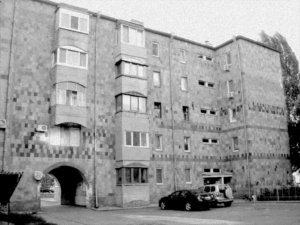
1 EXPLOSION
In the night of April 26, 1986, the fourth reactor of the Chernobyl Nuclear Power Plant exploded, unleashing one of the most traumatic events in contemporary history.
People had to be evacuated. Abandon their lives. Their homes, their toys, their furniture, their photographs. It was all left behind.
The numbers are difficult to calculate, but it is widely accepted that over 4000 people died as a direct consequence of being exposed to the radiation subsequent to the explosion.
The incident also had another direct effect to those living in the nearby area. People had to be evacuated. Abandon their lives. Their homes, their toys, their furniture, their photographs. It was all left behind.
Those working at the plant, and their families, had to be rehoused somewhere. It had to be done fast.
2 CONSTRUCTION
The Soviet Union, following the explosion at the Chernobyl Nuclear Power Plant, asked different Soviet republics to co-operate in building a new town, Slavutych.
Within 18 months, the youngest city in Ukraine was born.
The town, located 50 km from Chernobyl, would become an atomic city without a Nuclear Power Plant in sight, having a dedicated train that still today takes daily commuters in and out of the exclusion zone, preventing them from being exposed to large amounts of radiation.
The involved Soviet republics provided the master plan, the architects, the masons and the materials for the different districts, each inspired by the Soviet city where they came from: Baku, Tbilisi, Yerevan, Vilnius, Tallinn, Riga, Kyiv, Belgorod, Moscow and Leningrad.
Ten districts were built. Construction started in 1986. Within 18 months, the youngest city in Ukraine was born.
3 DISTRICTS
The construction of the districts followed the modernist premise of prefabricated panel housing; however, the formulation of the different neighborhoods is closer to a postmodern understanding of the world. Each district is made up of de-localized and interpreted architectural ornaments from different origins – orientalist arabesque in Baku, dark brick masonry in Tallinn – yet homogenous, existing within a framework of ordered and, to a certain extent, predictable urban morphology.
The district of Yerevan is cladded with the same pink stone that characterizes the Armenian capital, but an Ararat-less horizon reminds us of the transposed urban context.
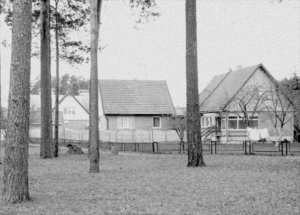
The Vilnius district has wooden cottages reminiscent of some sort of modernist Lithuanian vernacular: a Šnipiškės misplaced in time and space. The apartment blocks in that neighborhood have windows that tilt from a vertical central axis, which are apparently ubiquitous in Lithuania, but not in Ukraine. Locals complain that you cannot put mosquito screens on them in the summer.
Today, there are 13 districts in Slavutych. Three newer neighborhoods – Dobryninskyi, Chernihivskyi, Pecherskyi – were built in the decades to follow. They were inspired not by other places but rather by the modernist dream of the internationalist plattenbau, built at a time when they were being demolished elsewhere.
Slavutych is still living in the shadow of its own ruin.
Despite being located 15 minutes on foot from the central square, locals refer to them as the three ‘sleeping districts’, expressing their peripheral character.
Slavutych is the material evidence of a utopia built on the ruins of two of the most prominent ideologies of the 20th century, soviet communism and atomic theory, in the wake of their collapse.
Slavutych is still living in the shadow of its own ruin.
4 ATHENS
Athens also lives in the shadow of a ruin. Or several. The overruling narratives suggest the city to be in a permanent state of ruin: be it an archeological metaphor for ancient remains or a state of bankruptcy.
Whereas these two accounts hold true, ruins overshadow many other (hi)stories.
The metropolitan area of Athens is home to over 4 million people. It might be thought of as an ancient city, but the vast majority of it was built in the last century.
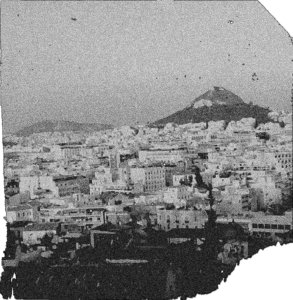
When King Otto established Athens as the capital of the newly independent Greek State in 1834, it was a small provincial town. Throughout the 20th Century, numerous waves of migration – refugees coming from Asia Minor, as well as people coming from other parts of the country to the city looking for a better life after a ravaging Civil War (1945-1949) – not only contributed to the exponential growth of Athens, but also brought with them fragments of other localities and practices.
Like Slavutych, Athens is made of fractions, but unlike Slavutych, they were not all built at once.
5 PROJECT
Athens and Slavutych are both situated in the borderlands, yet they are not peripheries, for it is in these regions that crucial issues are being dealt with, from political, to financial, to humanitarian crises.
Much like Athens, the future of Slavutych is ambiguous: with a large percentage of the population still working directly in Chernobyl, as the Nuclear Power Plant slowly shuts down, the prospects of the citizens remain uncertain.
Novarka, a joint venture led by two French companies, is one of the largest employers. Their task is to build a confinement dome over the fourth reactor. It was finished in November 2016, and most of the contracts ended within months of completion.
The bus stops in Slavutych, similar to other parts of the country, are filled with posters inviting people to join the army: there is still an open conflict in the Donbass region, in the East of Ukraine. Perhaps the lack of any other form of advertisement in a city that was designed without billboards makes their presence more prominent.
From crisis to crisis.
The idea of building the 14th District in Slavutych that would allow to reflect on these questions seemed to be an appropriate tool to imagine the future possibilities of this atomic city.
Celebrating the unique built heritage of Slavutych, the new district would be based on Athens, another city that has become iconic for the notion of crisis in recent times. The juxtaposition and embedding of these two contexts would trigger an enriching dialogue about architectural form and urban futures.
6 CHALLENGE
The project of the 14th District is driven by the urge to explore alternative ways of spatial planning:
Who would conceptualize the project? Who would own the project? Who would negotiate its realization in Slavutych? Who would care for the project?
It was decided that the new district would be designed by a group of locals that would form a core team, a Thinking Group that would engage in questions directly relating to the new district.
The project was organized around two questions: What does it mean to have a district in today’s Slavutych? How to translate one urban context to another?
The Thinking Group would spend the first half of the project in Slavutych, unpacking the implications of what a new district in Slavutych would mean what would the new district be like, would it need to attend to the needs of the citizens, if so, what needs, etc.
The second half would be spent analyzing the implications of the ‘translation’ process that emerge from taking one urban context into another. The compatibility. The extraction process. The processes.
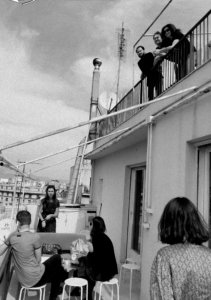
7 STEREOTYPES
After receiving the Mayor’s support it was decided that the 14th District would take place in one of the newer districts of the city – Dobryninskyi – in a plot of open space of over 5000m2.
An initial gathering was organized at the still empty territory of the 14th District, to meet locals and introduce the project to them. Many people came. They were curious. The idea was well received.
The 14th District would be a spatial intervention in the actual urban fabric of Slavutych, conceptualized by a group of local inhabitants.
Two questions were asked during the meeting:
What should the new district be? How does Athens look like?
People responded with what they knew: ideas of antique ruins, benches, community gardens and Aristotelian amphitheaters.
8 GROUP
An open call was announced in search of locals who, over the course of eight months, would explore the notion of ‘district’ in Slavutych and decide how to translate Athens into the urban fabric of their own city.
Five people were selected to be part of the Thinking Group that would conceptualize and realize the 14th District:
Dina Aleksashyna (1979),
works at Novarka, artist, lives in Riga district
Vadym Raksha (1995),
designer, lives in Dobryninskyi district
Sergii Rabchevskyi (1984),
works at Chernobyl NPP, deputy at Slavutych city council, lives in Belgorod district
Kateryna Shekhter (2001),
student, lives in Tallinn district
Iryna Brokh (1993),
journalist, blogger, lives in Belgorod district
For the following four months the Thinking Group met for lectures and workshops to discuss and unpack what a district in tomorrow’s Slavutych would mean.
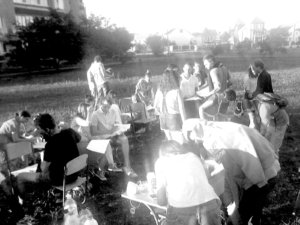
On one hand, this process was establishing a common ground among the participants of the Thinking Group, and deepening the understanding of the built environments of their city.
On the other hand, they were preparing for the second part of the project: a collective visit to Athens, where they would extract the design elements, the essence of what they wanted to bring back to the 14th District – the Athenian-inspired new neighborhood in Slavutych.
No one in the thinking group had ever been to Athens before.
9 10 PLANNING
The week in Athens would serve to distill design elements that would build on the knowledge that had been developed throughout the previous months in Slavutych. The culmination of this process would be the conceptualization and construction of the 14th District.
Besides the logistics and constraints of crossing the selective non-porous Schengen borders, the challenge remained of providing an encompassing representation of Athens, understanding that bias and subjectivity would be part of the experience. The participants of the Thinking Group would have to address that in their work.
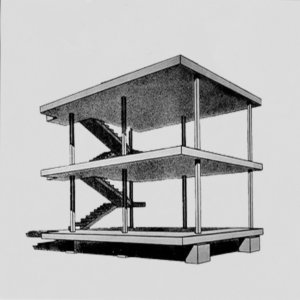
The week was organized in six episodes – one for each of the six days. The first chapter would address the notion of Ruin, as a common denominator for both Slavutych and Athens. Subsequent days would be spent looking at the city through different scales.
1.Ruin – as a common denominator of both spaces;
2.XL – the city
3.L – the neighborhood
4.M – the building;
5.S – the object;
6.XS – the particle.
These six perspectives would serve as a range of anatomic planes operating at different scales to dissect Athens, understanding its dynamics from the largest to the most minute.
11 RUIN
Ruins are the symbols of dominant perspectives for both Slavutych and Athens – the Chernobyl Nuclear Power Plant and the Acropolis being the most obvious ones.
The Thinking Group looked at the notion of ruin on their first day in the city.
From the top of the hill of the Acropolis, surrounded by cranes, tracks and preservation strategies that would be challenged and disassembled in the next few years by the next team of archaeologist, they saw Athens spreading out beneath.
But there are more current ruins that are part of the imaginary of the city today, such as the former airport of Hellinikon.
Hellinikon Airport stopped working as such in 2000, when the new airport was opened. Formerly the headquarters of what once was known as the world’s most luxurious airline, Olympic Airways, is now a semi-ruined building hosting a private exhibition of the history of the airline and its founder, Aristotle Onassis, as well as a refugee camp in one of the empty terminal buildings. The rest of it remains destroyed, after an arsonist set it on fire extinguishing evidence on malpractice during the nationalization of Olympic Airways.
Surrounding the airport, in the southern coast of Athens, numerous other semi-ruined infrastructural elements pierce the urban fabric. There are remnants of the 2004 Olympics, stadiums and pavilions that could not be maintained or did not find a suitable afterlife.
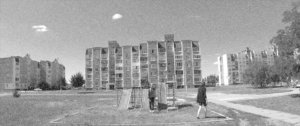
The most recent of all the ruins is the new National Library and National Opera, a ‘present’ from the Stavros Niarchos Foundation to the Greek government. The future for this building is not clear: it is unsure whether the governement, who still has not occupied the building, will be able to run the colossal structure. For the moment, a meticulous cultural program put together by the Foundation, and the novelty of the building, mean that there are often visitors. They roam around the empty bookshelves, sit in the vacant study rooms and climb to the top of the cavernous Opera hall. A proto-ruin; perhaps.
12 CITY
Because of its high population and relatively low density, Athens is vast. Surrounded by mountains West, North and East, and fringed by the sea in the South, the city spills over 58 municipalities, stretching from the rugged Mount Parnitha in the North to the port of Piraeus in the South.
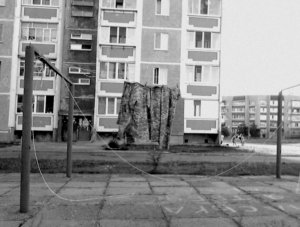
The Thinking Group started the day in the northern extreme, with the abandoned palace of Tatoï.
Tatoï used to be the residence for the Greek royal family, before the abolition of the monarchy in 1973. It is not an easy ride: in the middle of the forest, unmarked, and can only be accessed by a private vehicle, or after a long walk.
The next stop, nearby Kifissia, is one of the most affluent suburbs in the city, made up of grand old and modern villas, pedestrianized streets and global luxury brands intertwined with a carrousel of high street brands.
Spanning from Kifissia to Piraeus, the green line of the metro served the Thinking Group as a guide to dissect the city.
Cut by two stops – Victoria, a central neighborhood that is a home to multiple migrant and transient communities, and Petralona, a quiet residential area South of the center – the journey culminated at the quintessential Athenian gateway, the port of Piraeus.
From there one can see the suburban island of Salamina, which is perhaps the southernmost tip of the psychogeographic map of Athens.
The exercise of crossing Athens North to South lays out the city’s urban fabric that has been actively weaved, patched up and undone by disparate Athenian communities.
13 NEIGHBORHOOD
Athens is a city that is largely arranged through neighborhoods, much like Slavutych. With the arrival of different communities, new districts were created over the span of a few decades, rapidly changing the landscape of the city.
Neighborhoods represent the heritage of the everyday. Yet, it is difficult to use the same tools of examination deployed for other contexts when it comes to looking at the practices of mundane routines.
Through a set of guiding instructions that required the walker to focus on details of their environment, the participants of the Thinking Group were asked to explore different neighborhoods individually, and collect some of these impressions.
Furthermore, the unit of the neighborhood is also a strategy of resilience in contemporary Athens. The area of Exarcheia, formed by an amalgamation of community-engaged residents, is a great example. Many of the neighborhood groups operate, to a certain extent, outside the mainstream economic frameworks, for example, by implementing different forms of circular economies and alternative or localized currencies.
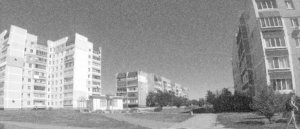
Resilience at a neighborhood level is not new in Athens: Anafiotika is a reduced enclave that emerged as an informal settlement in the mid 19th Century, and remained until today. Initially built by stonemasons that had been brought to Athens from the island of Anafi by King Otto to build his new capital city, the neighborhood resembles a Cycladic village. A few dozen of lime-washed micro houses, from 8m2 to 32m2, cover the northern cliffs of the Acropolis; providing a quintessential model of insular organic urbanization in the center of the city of Athens.
Neighborhoods in Athens serve as catalysts for individuals to operate as communities and develop strategies of resistance.
14 BUILDING
Polikatikia is the quintessentially Athenian building typology that allowed for the rapid expansion of the city. Because it emerged as a response to the housing shortage in the mid 20th Century rather than an architectural style, it is largely a procedural and legislative typology: apartment blocks would be built on private land that was acquired in exchange for a pre-arranged number of dwellings within the new construction.
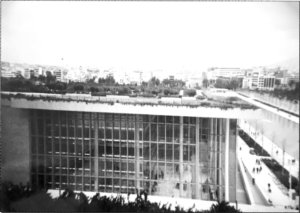
Polikatikia is more than just an inhabitable construction – it is a social edifice that would often preserve family relations due to the way it was built, but also preserve communities from outside the city once they had moved to Athens, at close proximity. Whole districts, such as Nea Ionia, Nea Smyrni or Nea Filadelfeia were built to house the refugees arriving from Turkey in Polikatikias – Nea here stands for ‘new’ and the second part of the name often indicates the territory left behind.
Penetrating the building, the flats and the rooms of Polikatikias allowed the Thinking Group to engage with mundane rituals and examine at close hand the societal and economical changes that this typology embodies.
15 OBJECT
Souvenir shops and stalls across the World have become homogenized enclaves where the same objects and memories are being sold. Only the name changes. The tourism industry represents the fastest growing field globally, and a financial lifeline in contemporary Athens.
Yet, souvenirs also serve to determine a power hegemony by establishing a hierarchy of heritage, deeming certain places, buildings, personalities, stories or objects in the city more important than others.
The Thinking Group was challenged to bring to the surface the subjective perceptions of the city, collectively acquired stereotypes and learned knowledge by modifying Athenian souvenirs and untangling their identitory and geopolitical undertones.
Subverting the stories and perceptions that these trinkets delivered was a form of appropriating and re-addressing how the city was understood.
16 PARTICLE
Out of sight, it is easy to overlook the minute. Yet particles and atomic relationships constitute the basis of matter.
Sound waves are a fundamental unit through which we experience the city: be it from the perceptions of the everyday to radio signals. The Thinking Group used listening and field recording devices as entry points to understand the city at the scale of the particle – as a subject of accountability to the different social entities that inhabit Athens.
The city was observed not just by earshot but sounds transcending geographies – through the lens of the radio wavelength. Radio signals allow establishing communities that are not assembled by territorial proximity but by interest and taste.
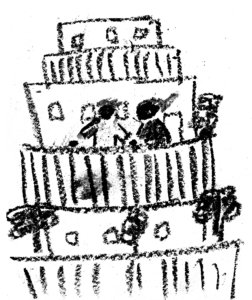
The surrounding mountains confine Radio waves to the basin of Athens, and scrolling through the different frequencies allows obtaining a polyphonic understanding of the urban fabric, transcending the tactile and the visual.
By understanding the city through this reduced scale it is possible to extract conclusions that can be observed at other dimensions: the city is made up of multitude of fragments that are in dynamic assemblage with one another. It is the relationship between these different parts that are able to establish a cohesive total.
17 CONCLUSION
Throughout the week, the Thinking Group was not only getting acquainted with the urban context of Athens but also developing strategies on how to translate their findings into the 14th District in Slavutych.
Looking beyond the Doric, ottoman or modernist, the group was determined to bring back to Slavutych a sensation of the city – an element that they felt had prevailed throughout their visit. The constant flux of feelings and the unpredictability that governs the relationships between people, spaces and buildings in Athens. A form of cohabitational chaos.
A seed for chaos. A trigger for change. A new beginning. An unexpected future.
Coming from the more homogeneously structured Slavutych, the idea of different elements coexisting in harmony next to each other provided a unique rhythm that the Thinking Group felt was the quintessential Athenian Element.
In terms of addressing the district, rather than seeing it as fulfilling a habitational purpose, or a finite element, they saw it as something that should be continuously evolving, a district in continuum, with change. They sought to provide a framework of change that would evolve over time, independently and slowly adapting to people, and people slowly adapting to it.
![Political Critique [DISCONTINUED]](http://politicalcritique.org/wp-content/uploads/2015/09/Political-Critique-LOGO.png)
![Political Critique [DISCONTINUED]](http://politicalcritique.org/wp-content/uploads/2015/09/Political-Critique-LOGO-2.png)